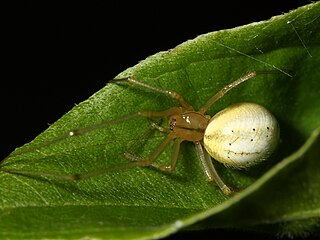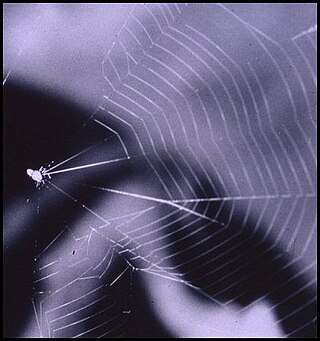
Theridiidae, also known as the tangle-web spiders, cobweb spiders and comb-footed spiders, is a large family of araneomorph spiders first described by Carl Jakob Sundevall in 1833. This diverse, globally distributed family includes over 3,000 species in 124 genera, and is the most common arthropod found in human dwellings throughout the world.

Oonopidae, also known as goblin spiders, is a family of spiders consisting of over 1,600 described species in about 113 genera worldwide, with total species diversity estimated at 2000 to 2500 species. The type genus of the family is OonopsKeyserling, 1835.

Scaffold web spiders (Nesticidae) is a family of araneomorph spiders closely allied with tangle web spiders. Like the "Theridiidae", these spiders have a comb of serrated bristles on the hind tarsi that are used to pull silk bands from the spinnerets. It contains 16 genera and about 300 species, many of which are associated with caves or overhangs. The genus Nesticus is the type for the family and is found throughout the world. The related Eidmannella has speciated considerably in Texas caves and includes some extremely localized species that are considered threatened. One species, Eidmannella pallida, is found in caves and under overhangs, but also in agricultural fields and other habitats away from such restricted areas. The genus Carpathonesticus is found in central Eurasia.

The ray spiders (Theridiosomatidae) are a family of spiders first described by Eugène Simon in 1881. They are most recognizable for their construction of cone-shaped webs. The family contains several genera which actively hunt for prey by using their webs to slingshot themselves towards prey.

Theridiosoma is a genus of ray spiders that was first described by Octavius Pickard-Cambridge in 1879. They use their web as a high speed slingshot to actively hunt for prey.

Tetrablemmidae, sometimes called armored spiders, is a family of tropical araneomorph spiders first described by Octavius Pickard-Cambridge in 1873. It contains 126 described species in 29 genera from southeast Asia, with a few that occur in Africa and Central and South America. Pacullidae was incorporated into this family in 1981, but was later restored as a separate family in a 2016 phylogenetic study.
Bertrana is a genus of Central and South American orb-weaver spiders first described by Eugen von Keyserling in 1884. It includes some of the smallest known araneid orb-weavers. Bertrana striolata females are 4.5 mm long or less. The eight eyes are in two rows. The abdomen is white on top and on the sides, with multiple hieroglyphic-like lines and bars of many different shapes and length. In females, these are red, in males, black.
Andasta is a genus of ray spiders that was first described by Eugène Louis Simon in 1895.

Ochyrocera is a genus of midget ground weavers that was first described by Eugène Louis Simon in 1892.
Metagonia is a genus of cellar spiders that was first described by Eugène Louis Simon in 1893.
Modisimus is a genus of cellar spiders that was first described by Eugène Louis Simon in 1893.
Pseudotyphistes is a genus of South American sheet weavers that was first described by Paolo Marcello Brignoli in 1972.
Chthonopes is a genus of southeast Asian ray spiders that was first described by J. Wunderlich in 2011. As of June 2020 it contains three species, found in caves of Laos, but can likely also be found in India and China: C. cavernicola, C. jaegeri, and C. thakekensis. They have several adaptations for darker environments, including pale coloration, long legs, and reduced lenses.
Chthonos is a genus of South American ray spiders that was created by Jonathan A. Coddington in 1986 because the previous name was preoccupied. Originally placed with the Orb-weaver_spiders under the name Tecmessa, it was transferred to the ray spiders in 1986.

Naatlo is a genus of ray spiders that was first described by Jonathan A. Coddington in 1986.

Ogulnius is a genus of ray spiders that was first described by Octavius Pickard-Cambridge in 1882.

Wendilgarda is a genus of ray spiders that was first described by Eugen von Keyserling in 1886.
Cuacuba is a genus of Brazilian ray spiders first described by P. H. Prete, I. Cizauskas & Antônio Domingos Brescovit in 2018. As of April 2019 it contains only two species.

Baalzebub is a genus of ray spiders first described by Jonathan A. Coddington in 1986. Spiders in this genus typically live in dark environments, like caves.














